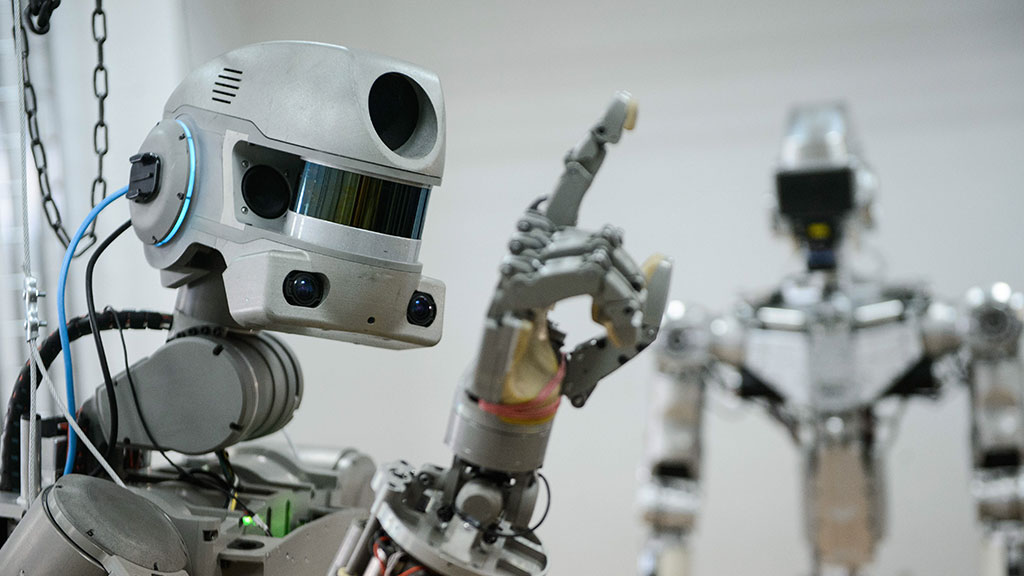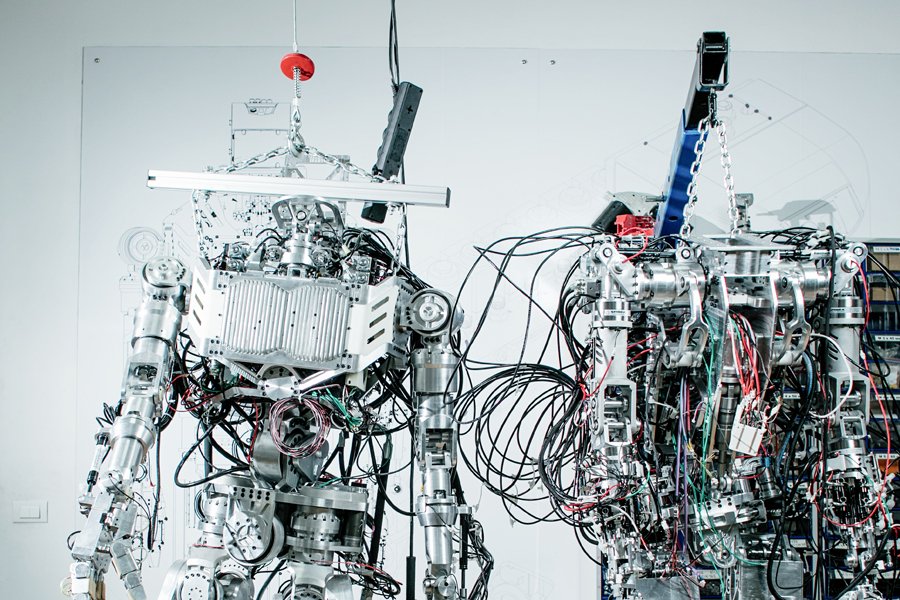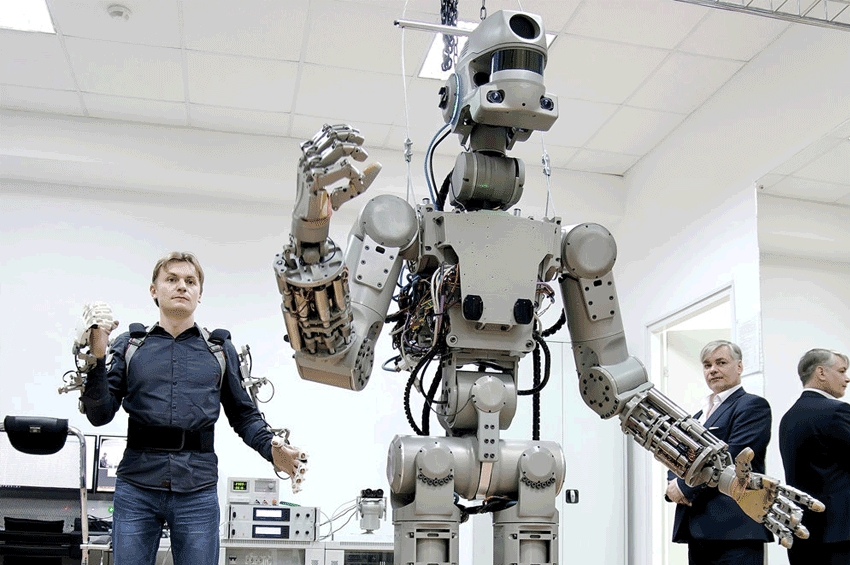Background: Robot Fedor, what are you?

On Habré several times mentioned the domestic development - the FEDOR robot (Fedor). The media also writes about this robot, in most cases mentioning its different capabilities (for example, shooting with two hands) and the fact that soon the robot will go to the ISS. Today's "Background" talks about how he was created, what he really can, and what his prospects are.
When and who made Fedor?
The official name of the project is FEDOR (Final Experimental Demonstration Object Research). The working title at the very beginning was Avatar. The name of the project was given by Dmitry Rogozin.
This project is being implemented by the Advanced Research Foundation in conjunction with the Android Technology NGO, commissioned by the Russian Emergencies Ministry. The goal is to develop a combined control system for an anthropomorphic robotic complex during rescue operations.
NGO is not new to robotics. This organization has existed for 13 years, during its work, NGOs have released 50 robots for private companies and state organizations. Among customers and partners are the Ministry of Industry and Trade, the FSB, the Ministry of Emergencies, the Ministry of Health, the Cosmonaut Training Center named after Gagarina, Russian Atomic Community, Rocket and Space Corporation (RKK) Energia and others. An NGO receives money from both private and public customers. The annual budget is about 500 million rubles.
Work on the creation of the system began in 2014 and continues to this day. The first to publish information about Fedor began in 2016.
Physically, the development center is located in Magnitogorsk, in the Alfa Center business center and several laboratories in the same city.
Fedor is created from scratch?
Not really. The basis is the previous models of robotic devices created by NPO Android Technique commissioned by Roscosmos. We are talking about the SAR-400 and SAR-401 models . Roscosmos needed an electronic-mechanical assistant for the astronauts working on the ISS.
Development is carried out in two stages. The first is experimental design work. At this stage, the developers created five technological layouts for testing software.

Photo: RBC
Two layouts looked like full-fledged robots, and the other three lacked several elements - for example, the upper or lower part. At the very beginning, the specialists wanted to use a hydraulic drive, but it turned out that the price is too high, and the reliability of such a system is low. Therefore, hydraulics was abandoned in favor of the electric drive.
How much is the project?
The developers spent about 300 million rubles, but it is still far from the completion of the project, so this is not the full amount.
What are the characteristics of the robot?
His height is 180 cm, weight is about 160 kg. Power - 13.5 kW (20 horsepower).
The robot consists of 15 thousand parts.
Software is a real-time operating system developed in St. Petersburg on the basis of Linux.
Work in standalone mode - 1 hour, it is charged through a conventional outlet.
Robot - completely domestic development?
There is no exact information on the percentage ratio of domestic and foreign components for all robot prototypes. Nevertheless, it is known that for one of them 50% of the parts were manufactured in Russia, the rest are assembled on special order in Japan, Germany, the USA, Switzerland and other countries. The software for the robot is developed on the basis of Linux, so it is also difficult to call it exclusively Russian.

Photo: RBC
90% of electronic components for the robot are produced in Russia by various organizations, including Abris-Technology and Silicium enterprises from St. Petersburg.
Is Fedor controlled by an operator?
The first prototypes worked exclusively under the control of the operator. It has now become known that Fedor has already learned to act autonomously, and this is a self-learning system. The robot receives information about the environment and its parameters from a variety of sensors:
- two cameras;
- thermal imager;
- a microphone;
- GPS and GLONASS;
- 15 rangefinding lasers;
- special system for determining the position of your body.
Fedor can identify typical objects and tools and distinguishes obstacles. He brings all this into a three-dimensional diagram of the environment. At the moment, he knows how to open the door, use a drill, shoot a pistol, drive a car and an ATV offline .
In the future, developers plan to train the robot to independently determine the task. For example, if Fedor sees a victim during an earthquake, whose leg is crushed by a concrete block, he will "understand" that to free a person, he needs to remove the block and take the victim to a safe place.

Photo: RBC
In addition, the robot can act in copy mode. In this case, the operator puts on an exoskeleton that repeats the structural features of Fedor. Well, the robot copies the movements of the operator. As far as you can understand, two-handed shooting was carried out under the control of the operator.
The operator can be thousands of kilometers away from the robot; telemetry is transmitted via satellite. The operator can control the robot also in supervisor mode - without setting the movement with the help of an exoskeleton, and show what needs to be done on the screen.

Photo: robo-sapiens.ru
Developers say that the operator can be a doctor, military, lifeguard or any other specialist. So, if necessary, the robot can perform a variety of functions, from the study of a radiation-infected landfill to construction work.
According to the developers, Fedor’s electronic mechanical base is not inferior to ATLASdeveloped by DARPA. But the software package is not so perfect. In particular, because thousands of programmers work with ATLAS, and only those who are directly related to the project work with Fedor.
Why was the robot taught to shoot?
The developers claim that this is done only to demonstrate the capabilities of the system. To solve problems such as aiming, target selection, ability to reduce returns, etc. specialized algorithms need to be developed, and this is many months, if not many years of work. And Fedor is not a military development.
Where do you plan to use Fedor?
The main scope of its application is saving lives. He will work in territories and in buildings with chemical and radiation contamination. Now the Advanced Research Foundation, together with Rosatom, is creating prototypes that will be able to sort radioactive waste.
Fedor has a good monitoring of “hands”, so he is able to help people in the workplace. Perhaps he will be taught to help assemble other robots.
It can be good in sapper business, in medicine (already now the robot is able to make injections and apply tires). Unfortunately, more or less delicate work is carried out only when the operator is controlled.
In 2021, Fedor will be sent on a flight on the Federation spaceship. However, for this, the developers will create a new version of the system that will meet all the requirements of the rocket and space industry. More reliable electronics, a capacious battery, smaller sizes - all this must be realized before 2021, and very little time is left.
